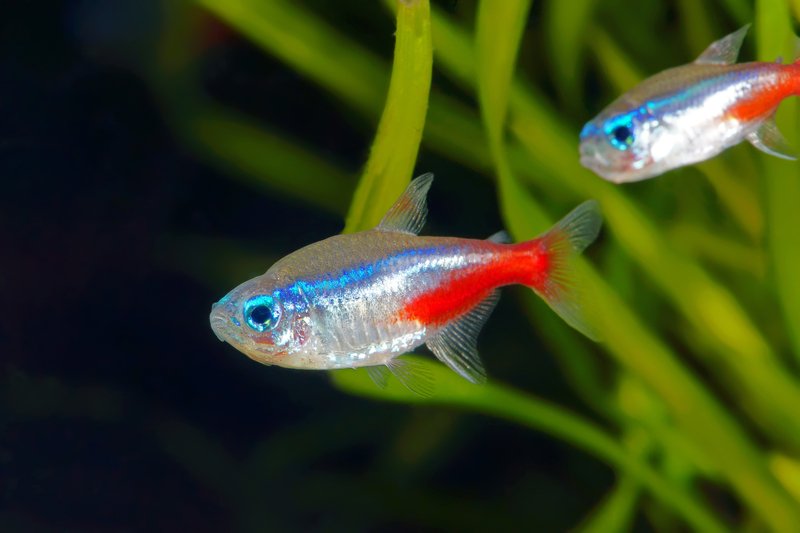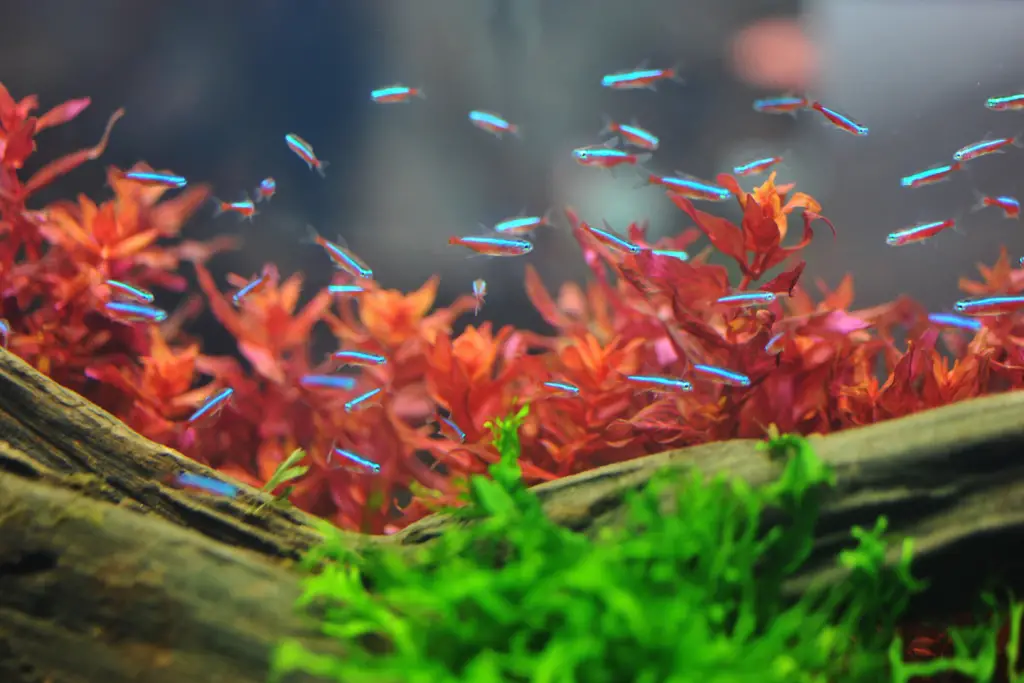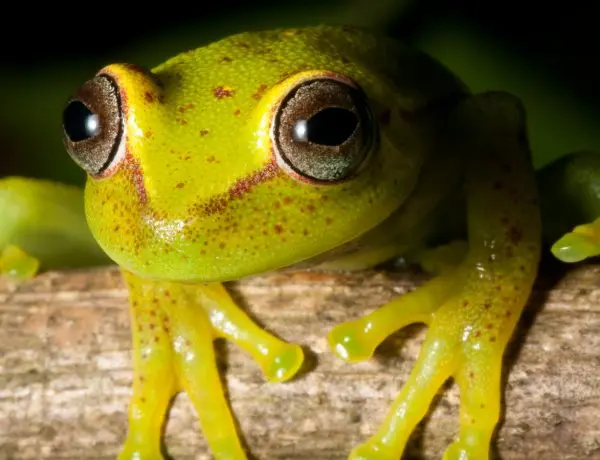Whether you have had an aquarium for years or are looking to get one, most people will want more than one type of fish in it. You may have noticed the beautiful Bettas and Neon Tetras and wonder whether they can live together harmoniously?
Can Betta and Neon Tetra live together and get along with each other?
The answer is yes. Bettas (also known as Japanese or Siamese fighting fish) and Neon Tetra fish can coexist in the same tank, but only if the tank is large enough. Although Betta and Neon Tetra Fish often show aggressive tendencies, they will typically become friendly cohabitants if they are instead introduced together in appropriately sized aquariums.
The beauty of having both Betta and Neon Tetra living together in one tank can be enticing, but the reality of maintaining their happy home can sometimes get a bit more tricky. Here is a guide of tips, tricks, and advice we have put together in order to ensure that your Betta fish and Neon Tetra fish can live together blissfully!
Table of Contents
Buying the Right Bettas and Neon Tetras
Buying healthy fish is the first step to ensuring your combined Betta and Neon Tetra tank’s success. Though Bettas typically come from Southeast Asia and Neon Tetras originated in the Amazon, these fish can live together if healthy when purchased.
When choosing fish for your aquarium, remember these important facts:
- female Bettas will tend to be less aggressive than male Bettas
- male Bettas will pose a greater risk to the Neon Tetras that they are living with
- healthy Neon Tetras have energy and enjoy swimming
- healthy Bettas have a ravenous appetite
- when purchasing your Neon Tetras, make sure that you are buying from a trusted source where the fish are naturally neon, rather than injected with an artificial coloring
The Key to a Successful Aquarium
When setting up your aquarium for these two species, make sure you buy one that can hold at least 15 gallons of water, but 25 or more gallons of water would be preferable. Too small of a tank will likely lead to fighting between the Bettas and Neon Tetras.
When the fish have plenty of room and don’t need to compete for shade or plant cover, their chances of fighting decrease dramatically. Place the tank in a room without any direct sunlight and add plenty of decor such as:
- rocks
- leafy plants
- pieces of wood
- other non-plastic items (plastic tends to deteriorate over time)
Adding and Circulating Water
Step 1: When adding your water to the tank, first make sure it is not contaminated with any sort of chemical substance.
Step 2: Add the water slowly, checking to ensure that there isn’t an excess of bubbles popping up.
Step 3: After adding the water, install a circulation system so that you can periodically cycle the water. This keeps the water from getting murky and dirty. Having a clean tank will keep your fish happier and stress-free. You can purchase a simple aquarium circulation pump on Amazon.
Introducing the Fish

When putting your Bettas and Neon Tetras into their tank, make sure to add them in the right order. Fish can be very territorial, and if they are introduced in the wrong way, it can lead to fin-nipping, aggression, and fighting. The order should be the tetras first, and then the Betta.
Why Tetras First?
Here’s why you should add your Neon Tetras to the tank first:
- It will allow them to form family groups (make sure to purchase 4-10 of them, depending on the size of your container)
- They will find a sense of safety in numbers
- It will give them time to adjust to their new home
- When Neon Tetras feel safe and adjusted, they will not be as prone to fin-nipping
Adding the Bettas
When you add your Betta fish to a tank that already includes Neon Tetras, be sure to keep a close watch for the first 24 hours or so.
Choosing female Betta fish (with shorter fins) tends to create a calm and pleasant aquarium atmosphere. Remember, there is always a risk when introducing two different types of fish to each other in the same tank.
If you notice any hostile behavior from your Bettas or from your Neon Tetras, be prepared to remove your Bettas immediately. You can do so by scooping them out of the tank and placing them in a small bowl or pitcher containing water of the same temperature.
How to Know Your Fish Are Happy
You’ve added your Bettas and Neon Tetras to the same tank and haven’t noticed aggressive behaviors from them in the last 24 hours. But how do you know if their cohabitation will be long-lasting?
Signs that Bettas and Neon Tetras are Coexisting

Feeding Time—you will know your Bettas and Neon Tetras are happy together when feeding time goes smoothly. If the fish swim to the surface when you feed them and seem to be focusing on the flecks of food rather than each other, odds are that they have become friends. When they can eat without fighting for food or territory, it is a sign that they are coexisting properly.
Watch for Colors—a great way to know that your Bettas and Neon Tetras are living harmoniously is to watch for vibrant colors. When Betta fish are content with their tank mates and within their environments, they tend to gain a more bright and colorful appearance. Dull scales and colors are a good way to know that your fish’s happiness needs some work.
Schooling Habits—when Bettas and Neon Tetras are getting along, they tend to cross paths as the Neon Tetras perform their schooling habits. When Neon Tetras are in small groups, they school or swim in tight groups. If you see your Neon Tetras schooling past your Bettas, odds are that they are on good terms.
The Danger Signs
While it is entirely possible for your Bettas and Neon Tetras to live together happily, it is crucial to be aware of the danger signs in case your fish are in distress due to their living situation.
Know if your Bettas and Neon Tetras aren’t getting along
A popular Betta site says, “The number one sign that they may be stressed or unhappy is their eating habits. While a happy Betta fish will scarf down food, a depressed Betta will barely eat. If your Betta is picking at his food or starts to ignore it, then that’s a huge red flag.”
Another sign that your fish may need to be separated is a lack of movement. If your Betta fish looks like it is dipping low at the bottom of the tank and lacks the energy to move around, it could be depressed. Try moving your Betta to a smaller tank without other fish, and monitor its behavior. If it begins to swim around, its unhappiness may have been due to sharing a home with the Neon Tetras.
Unlikely Friends
Despite the Betta fish’s reputation for unprovoked aggression and the Neon Tetra’s habit of fin-nipping of other fish, there are many reasons that Bettas and Neon Tetras are actually great fish to live together:
- They like the same tank temperature (73-81°F)
- They eat the same type of food (brine shrimp and bloodworms)
- Betta fish swim near the top of the tank while Neon Tetras like the middle
- They have similar sleeping schedules
- They both dislike direct sunlight
Betta and Neon Tetra Together
With Betta’s popularity on the rise and the growing desire to introduce more than one species of fish into a single tank, carefully keeping Betta and Neon Tetras together can make for a beautiful and practical pair.
Betta fish and Neon Tetra fish can coexist easily with the right attention to:
- Tank
- Decor
- Water
- The way you introduce the fish
Under the right conditions, they can even thrive. It may take a little bit of extra work and close observation on your part, but having these two kinds of fish in the same aquarium can be quite lovely.




